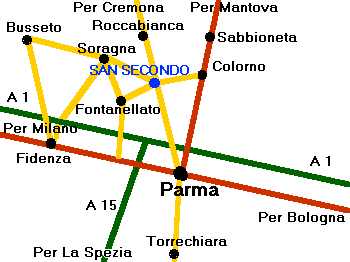
HOW TO REACH SAN SECONDO

San Secondo lies along the banks of the Taro River, in the midst of a vast plain crossed by straight roads connecting the town to larger highways such as the A1 Toll Road. Arriving from Milan, take the Fidenza exit from the A1 and proceed north through Soragna. The turn – off for San Secondo is just after Soragna. Arriving from Bologna, exit at Parma, go through Parma and take the provincial highway toward Cremona. San Secondo is about 9 miles from Parma. Approaching from the west, exit from the "Autostrada della Cisa" at West Parma, then go about 6 miles beyond the town of Pontetaro. The directions are the same if you are travelling on Via Emil. Coming from Mantua, take State Highway No. 420 toward Sabbioneta, then No. 343 toward Colorno, where you turn west toward San Secondo.
HISTORY
There is evidence of human presence in this area as far back as the Bronze age, but it was not until the time of the Romans that real colonization took place.
During the early Middle Ages organization of the territory developed, culminating in the construction of the two most important churches, San Secondo’s Church and San Genesio’s.
The former is unfortunately no longer standing; the latter is still well – preserved and stands southwest of town.
San Secondo (or " lacum Sancti Secundi", as it was called then) was mentioned as part of the territory belonging to the Cathedral of Parma in 894 A.D. in a letter from King Arnolfo to Bishop Wibodo.
There are various documents testifying that the ownership of the territory belonged to Parma throughout the centuries that followed, up until 1365, when Bishop Ugolino Rossi gave the land to his nephew Giacomo, who became the first Count of San Secondo. As early as the 12th century, the Rossi Family was already very prestigious.
Their greatest hour was during the rule of Pier Maria II, called "The Magnificent", from 1438 to 1482. At that time a state was formed which extended from the Appenine Mountains to the Po River and along the valleys of the Parma and the Taro Rivers.
The Rossi Family continued to rule the area for centuries to come, and became related with some of the most important people of the Renaissance, including the King of France, Louis XII, Giovanni of the Black Bands famous leader of troops, father of Cosimo de’ Medici I, Duke of Florence and Grand Duke of Tuscany, and Federico Gonzaga II, Duke of Mantua, as well as various popes, including Pope Paul II, Pope Julius III, and many artists and scholars, as Giulio Romano, Francesco Mazzola called "Parmigianino".
Pier Maria III, seventh Count and second Marquis of San Secondo was sent to the court of the King of France to study martial arts, political science, and art. During the 16th century the Rossi Family struggled against the Farnese, who won and dominated the area until 1731.
In 1817 the last count died without leaving an heir.
PLACES TO VISIT

San Secondo Castle: In the 16th century, the Rossi castle was decorated in extravagant style, with frescoes by the best artists of the time, in order not to appear inferior to the new lords of Parma, the Farnese. Only the northwest wing and the northeast façade remain of the 16th –century structure. During the last part of the 19th century, a large part of the castle was destroyed. The beautiful Renaissance courtyard, the main staircase and the reception hall, and the frescoes on the piano nobile are all that is left today.
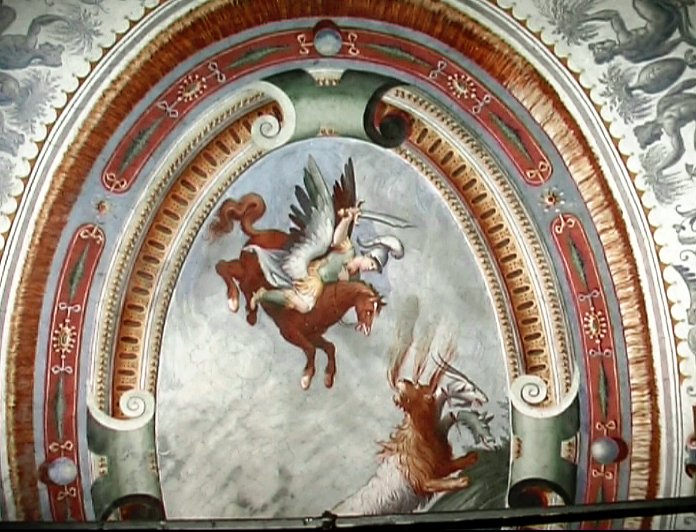
"The Hall of Bellerofonte": Beyond the courtyard and the main staircase, this grand hall houses the most important equipment for the San Secondo Palio. On the ceiling is a fresco of Bellerofonte killing the chimera, a monster with the heads of a lion, of a dragon and of a goat, representing the fight between the Good and the Bad.
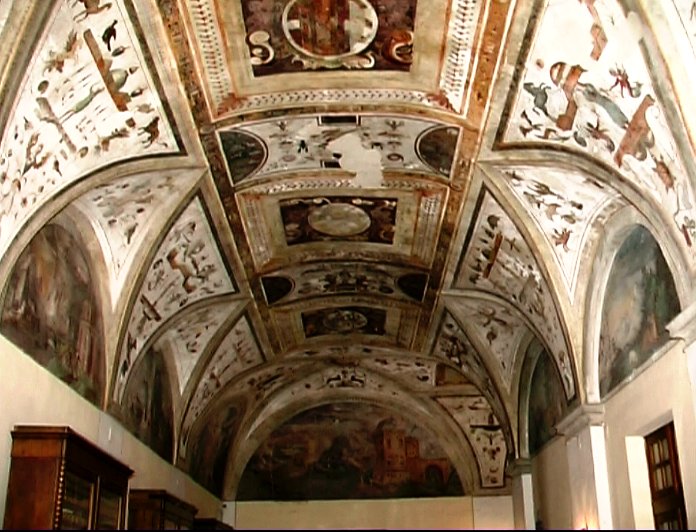
Aesop’s Gallery: This is an L-shaped corridor, with frescoes illustrating the most famous fables, including "The Fox and the Wild Pig", "The Fox and the Lion", and "The Wolf and the Lamb".
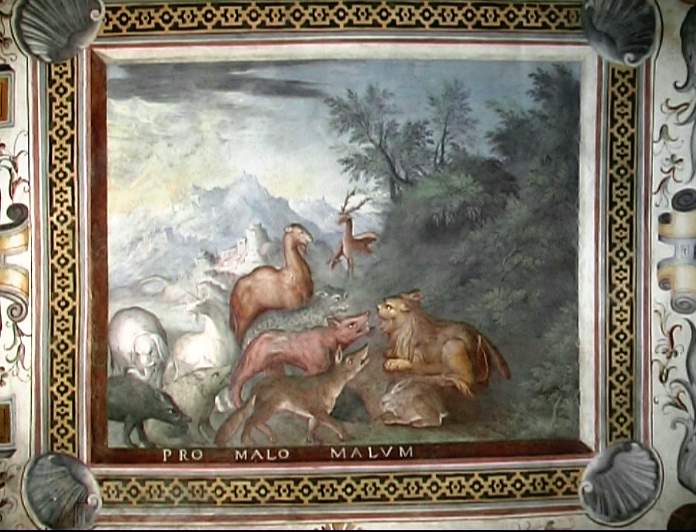
The "Hall of Fables": More fables in this room include "The Dog and the Rooster"; all of the illustrations have captions in Latin underneath.

The "Hall of Slander": In this room there is an actual comic strip, which narrates the story of the father and son who set out for market with a donkey. As the story goes, they are so criticized by passerby for using the donkey, that they end up carrying the donkey on their backs. The caption is "Momus ubique", or "slander can be found everywhere".
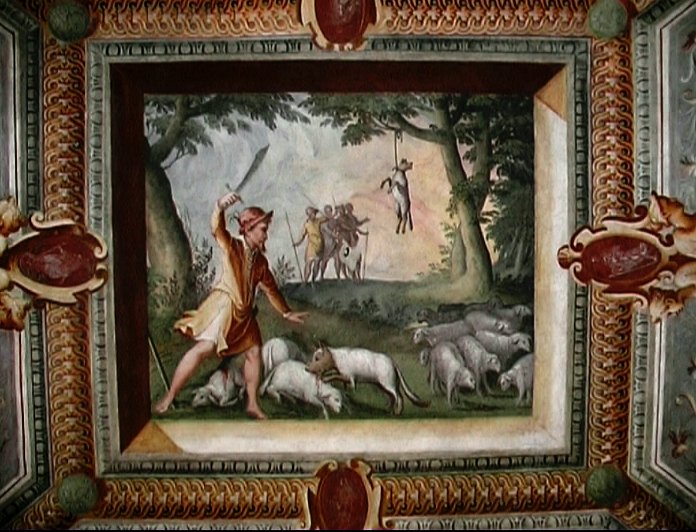
The "Supper Hall", "Wolf’s Hall", and the "Hall of Justice": These are the last three rooms in the west wing, and bear further illustrations of Aesop and Phaedrus’ fables, including the one about the wolf in sheep’s clothing. Each room bears a representation of the four seasons and imposing scenes of grotesquerie or other interesting landscapes.
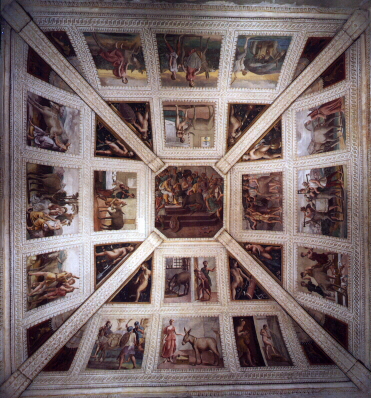
"Caesars’ Hall", and "The Hall of the Golden Donkey": These rooms hold the oldest illustrations Pier Maria III had painted. Caesars’ Hall, with the Roman emperors, matrons, knights and ladies, holds some of the finest work. The Hall of the Golden Donkey has 17 paintings from a story by Apuleius entitled "The Metamorphosis of the Golden Donkey". No other paintings illustrating this famous Latin novel are known to exist. The story begins on the bottom strip, over the western door, and moves counterclockwise around the room. It continues in the upper strip and concludes at the center of the vault.
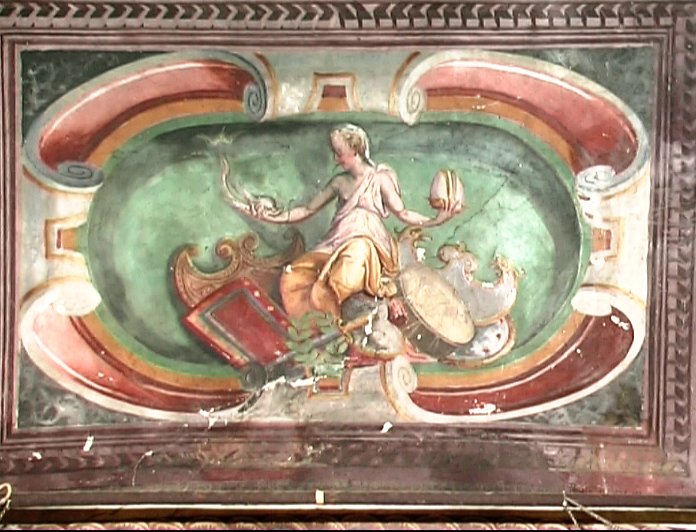
"Athlete’s Hall": Beginning from this room, the pictures in the following rooms represent mythological subjects. Here we see two athletes, Ganymede and Atheon, holding up the vault.
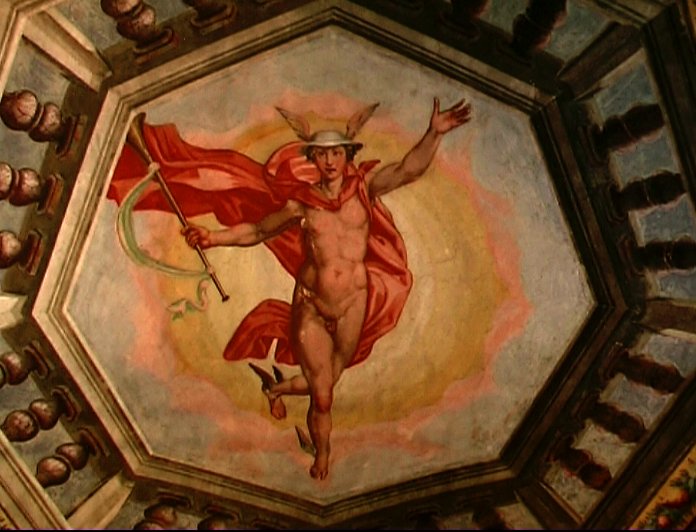
"Mercury’s Hall": The messenger of the gods is portrayed with a winged helmet, wings on his feet, and a caduceus in hand, and allegories of arts and sciences.
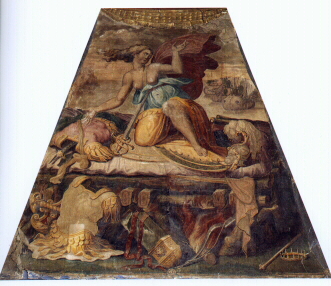
"Circe and Dido’s Hall": Here Circe is portrayed transforming Ulysses’ men into pigs, and Dido committing suicide. It is thought these scenes probably represented what the Rossi Family was experiencing during their most difficult years: Circe and Dido wanted power, but never succeeded in getting as much as Troy.
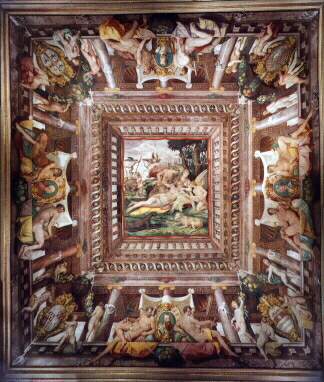
"Latona’s Hall", "Adonis’ Hall", and "The Giants’ Hall": The frescoes in these rooms deal with the same subject: the punishment inflicted on those who dare defy the gods, the laws of the land, or the powers that be. The scenes depicted are almost all taken from the "Metamorphoses" by Ovidio. Numerous friends and important relatives of the Rossi Family are portrayed in the medallions in Adone’s Hall. These include Gian Girolamo Rossi, Bishop of Pavia and Governor of Rome, illustrious Renaissance writer and poet, Federico Gonzaga II of Mantua, cousin of Camilla, wife of Pier Maria III, Giovanni de’ Medici, called Giovanni of the Black Bands, the most important and the best loved, who died very young at only 28 years of age in 1526. In the Giants’ Hall we see the giants who have dared defy Jupiter, and have been thrown out of Olympus. There is Prometheus tied to a rock, and Icarus falling into the Aegean Sea.

The Hall dedicated to the Rossi Family’s Military Prowess: This is a majestic, imposing room over 78 ft. long, 39 ft. wide and 41 ft. high, with more than 12,916 sq. ft. of frescoes. There are 13 tapestries depicting episodes from the life of the Rossi Family. In the last of these the King of France bestows St. Michael’s collar, the greatest military honor, on Pier Maria III, and names him Chief General over his troops. Other important episodes are the victories over Federico II in 1247 (picture no. II) and in 1248 (picture no. III), the battle of Campaldino in 1289 (picture no. IV), the battle of Borgo San Donnino against Azzo Visconti in 1325 (picture no. V), Pier Maria the Magnificent’s entry into Parma in 1470 (picture no. X), and the siege on Padua in 1503 (picture no. XII).
There are guided tours to the castle from Tuesday to Sunday at 10 a.m., 11 a.m., 3 p.m., 4 p.m., 5 p.m., and 6 p.m. The 6 o’ clock tour is not given from November 1st through March 31st. The castle is closed Monday, except when a holiday. It is possible to book guided tours for school groups (evening as well), and to have picnic in the park surrounding the castle. A reservation is required for small groups as well. Call +39 0521 873214 or fax +39 0521 872147 for reservations.

Night tours and evocations can be booked for the last Saturday of the month for groups of 20-50 people. The characters act out episodes from life inside the castle during the Renaissance: Giovanni of the Black Bands hands the reclaimed fief over to his sister in 1522, scenes of Pietro Aretino, the love story between Camilla de’ Rossi Pallavicino with her uncle Giovanni, and so on. Only in italian (renaissence) language. It's necessary to reserve. Call +39 338 2128809.
OTHER MONUMENTS
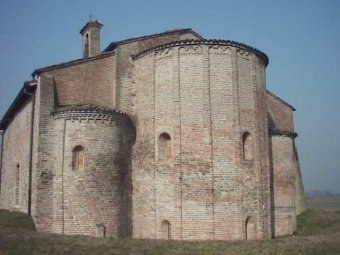 San Genesio’s
Romanesque Church: This is the oldest Romanesque monument in
all of the lowland of Parma. It stands in open countryside about
one mile from San Secondo. It was designed with a nave and two
aisles, each of which terminates in an apse. In 1787, the church
was shortened by three arches, leaving it two thirds its original
length. The apses are the oldest part of the church. The central
one is larger than the other two, and holds more elaborate
decorations. There were originally three altars in the church.
San Genesio’s
Romanesque Church: This is the oldest Romanesque monument in
all of the lowland of Parma. It stands in open countryside about
one mile from San Secondo. It was designed with a nave and two
aisles, each of which terminates in an apse. In 1787, the church
was shortened by three arches, leaving it two thirds its original
length. The apses are the oldest part of the church. The central
one is larger than the other two, and holds more elaborate
decorations. There were originally three altars in the church.

The Blessed Virgin "del Serraglio": This chapel once held an image of the Virgin thought to be capable of miracles. Built at the end of the 17th century, it preserves beautiful frescoes by Sebastiano Ricci and Ferdinando Galli called Bibiena.
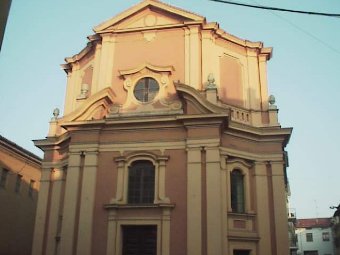
St. Louis’ Chapel or "del Riscatto": This was built between 1717 and 1728. It houses a beautiful carved wooden altar.

Church of the Blessed Virgin of the Annunciation: This was built around 1450 by Pier Maria Rossi "the Magnificent", and originally had a single nave. In 1716 the two side aisles were added. The church houses important works of art.
Mercy Hospital: The hospital was commissioned in 1630 by Count Federico I to care for the poor during a plague. When he died in 1634, work dragged on for more than a century. In 1716 it was still not finished.
THE "PALIO DELLE CONTRADE"
This "Palio" was instituted in 1990 and recreates the celebration held in 1523 when Pier Maria III married Camilla Gonzaga of Mantua.
It is held the first Sunday of June. The cast of the various pageants enacted during the four-day celebration is made up of Bianca Riario, widow of Troilo I in 1521, and her children Pier Maria III, Giovan Girolamo, Bertrando, Ettore, Giulio Cesare, Angela Paola, Camilla and Costanza.
The celebration begins on the Thursday before the first Sunday in June, with a 16th-century concert in the courtyard of the castle for guests from neighbouring manors and local officials. Together they tour the village, where there are stands showing 16th-century crafts, and then a banquet is given featuring traditional local foods.
On Saturday Bianca Riario greets the bride and groom who have arrived from Mantua, the lords of the "contrade" (districts) pay homage to the count and his family, and the horses are prepared for the Palio race.

Sunday’s program involves the entire village with parades in costume (about 1000 characters), decorations on the houses in the town and banners in the streets.
In the morning Bianca and her family go to mass and attend the blessing of the horses and the knights. In the afternoon the Palio takes place.
An evening of banquets and merrymaking conclude the "Palio di San Secondo" for another year. The names of the "contrade" of San Secondo are "Buregh di Minen", "Castell’Aicardi", "Dragonda", "Grillo", "Prevostura", and "Trinità".